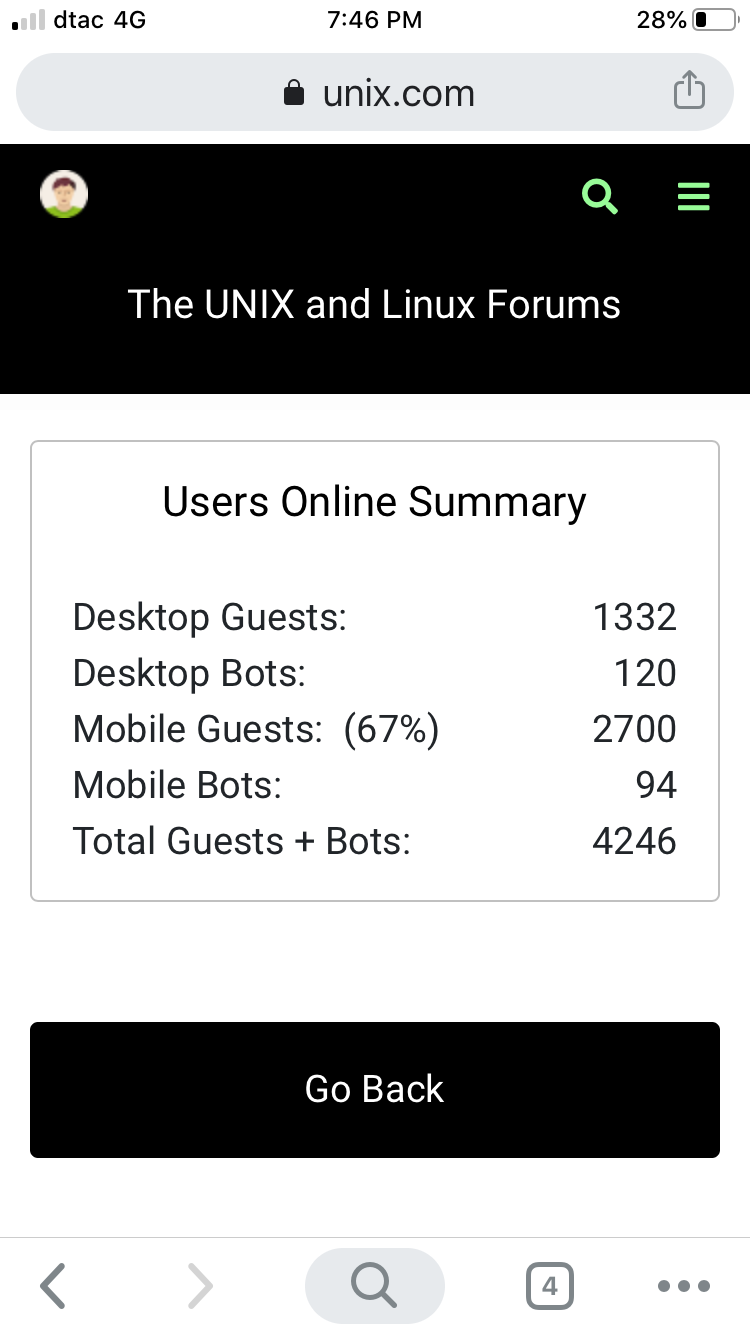|
|
Sponsored Content
Top Forums
Web Development
Discrepancies Between Our Mobile Detection Code and Google Analytics Regarding Chinese User Agents
Post 303040163 by Neo on Thursday 24th of October 2019 10:31:08 AM
|
|
5 More Discussions You Might Find Interesting
1. Shell Programming and Scripting
Well, I'm losing my regex ability in sed! Please help.
I need to search for this text in multiple html files in a directory:
</body>
and add the following lines in front of the text above:
<script src="http://www.google-analytics.com/urchin.js" type="text/javascript">
</script>
... (11 Replies)
Discussion started by: Neo
11 Replies
2. Google Chrome OS
I know that Google Chrome came out with the Android under a Unix based system, but did it come out yet for Windows Mobile? I have Windows Mobile 6 on my device. (0 Replies)
Discussion started by: Anna Hussie
0 Replies
3. Shell Programming and Scripting
Hi,
Can anyone help me write a script tp determine the web browser from a user agent. A user agent is stored in a file and consists of hundreds of lines e.g.
37050 Mozilla/5.0 (Windows NT 6.1; WOW64; Trident/7.0; rv:11.0) like Gecko
29404 Mozilla/5.0 (Windows NT 6.3; WOW64)... (4 Replies)
Discussion started by: cyberfrog
4 Replies
4. Web Development
Over the past 10 plus years, we have countless posts where the user did not use CODE tags or they used ICODE tags incorrectly.
This has has the results of this site penalized by Google for having pages which are "not mobile friendly".
So, working quietly in the background, in the thankless... (0 Replies)
Discussion started by: Neo
0 Replies
5. What is on Your Mind?
For the first time in the history of the site Google Search Console (GSC) has unix.com showing "no mobile viewability errors". This is no small achievement considering the hundreds of thousand of lines of legacy code we run at a site which has been around much longer than Facebook or LinkedIn:
... (0 Replies)
Discussion started by: Neo
0 Replies
LEARN ABOUT DEBIAN
rapi_connection_from_name
RAPI_CONNECTION_FROM_NAME(3) http://www.synce.org/ RAPI_CONNECTION_FROM_NAME(3) NAME
rapi_connection_from_name - obtain connection for RAPI function calls SYNOPSIS
#include <rapi.h> RapiConnection *rapi_connection_from_name(const char *device_name); RapiConnection *rapi_connection_from_info(SynceInfo *info); void rapi_connection_select(RapiConnection *connection); void rapi_connection_destroy(RapiConnection *connection); HRESULT CeRapiInit(); STDAPI CeRapiUninit(); DESCRIPTION
The rapi_connection_from_info() function returns a pointer to a newly allocated RapiConnection struct, used for remote function calls to a mobile device. The RapiConnection keeps a pointer to the SynceInfo struct but does not copy it, therefore freeing the SynceInfo before the RapiConnection is not recommended. rapi_connection_from_name() accomplishes the same for the connected device named device_name. Refer to synce_info_new(3) for insight on how this name and the connection daemon in use can affect the device contacted. rapi_connection_select() allows for selection between multiple active connections. NULL can be passed to result in no active connection. rapi_connection_destroy() frees a RapiConnection. This should not be called before CeRapiUninit(). CeRapiInit() connects the current RapiConnection to it's mobile device. If already initialised, CERAPI_E_ALREADYINITIALIZED is returned. CeRapiUninit() destroys the connection for the current RapiConnection. The RapiConnection cannot be re-initialised, it must be destroyed. An example of using multiple devices follows. /* * SynCE support for switching between multiple devices * * Example code for two devices follows! * * It shows two different ways to get a RapiConnection object. * */ RapiConnection* a = rapi_connection_from_name("device_a"); rapi_connection_select(a); CeRapiInit() SynceInfo* info_b = synce_info_new("device_b"); RapiConnection* b = rapi_connection_from_info(info_b); rapi_connection_select(b); CeRapiInit() rapi_connection_select(a); ...some RAPI calls to device A... rapi_connection_select(b); ...some RAPI calls to device B... rapi_connection_select(a); CeRapiUninit(); rapi_connection_destroy(a); rapi_connection_select(b); CeRapiUninit(); rapi_connection_destroy(b); synce_info_destroy(info_b); RETURN VALUE
rapi_connection_from_name() and rapi_connection_from_info() return a pointer to a new RapiConnection. CeRapiInit() and CeRapiUninit() return S_OK on success or an error code on failure. AUTHOR
This manual page was written by Mark Ellis <mark_ellis@users.sourceforge.net>. SEE ALSO
synce(7), synce_info_new(3), odccm(1), vdccm(1) The SynCE Project 2007-08-26 RAPI_CONNECTION_FROM_NAME(3)
